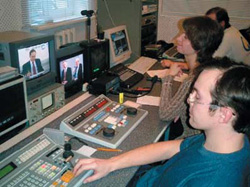
Photo: USAID/Russia Inna Bashina
SCAT TV taping US Ambassador Vershbow’s roundtable with leading economists and political scientists.
“People only believe you when what you say is objective and professional. This is the key to popularity and success.”
- SCAT TV President Nikolai Fomenko
|
Initiative
To increase the opportunity for access to independent programming in Russia, USAID has trained TV professionals in program production, marketing, advertising, management and business planning, as well as provided modern programming equipment for journalists to produce programs.
Modern reporting required new technology. USAID gave 288 independent Russian TV companies computer software to produce fact-based news and analytical programs. These programs are shared with independent TV companies throughout Russia via a USAID-funded online news exchange system. More than 100 regional TV companies participate in this program and have already exchanged over 65,000 news programs with their peers.
|
|
USAID also helped Russian independent TV stations to establish a new video exchange network, called Province, which provides the best regional stories to 75 independent TV stations reaching 70 million people.
Results
The introduction of news exchange facilities marks an unprecedented breakthrough in the Russian TV industry, enabling independent TV companies to reach audiences throughout the country and to boost cross-regional awareness. This is critical for a country with eleven time zones and nearly twice the size of the United States. USAID has trained over 600 independent regional TV companies and more than 11,000 TV professionals. Today quality programs on pressing social issues such as domestic violence, trafficking prevention, drug abuse, smoking, drinking, healthy lifestyles, child abandonment and environmental issues are produced by USAID-trained journalists. SCAT TV, one of the first independent Russian TV stations, now produces more than twenty original programs. SCAT TV’s staff has grown to 300 professionals with its journalists participating in over sixty USAID-funded training
Print-friendly version of this page (257kb - PDF)
|
|


